Like Emily Jordan Folger, Henry Clay Folger manifests his deltiological profile in two ways. First, he purchases picture postcards and sends them to his wife when he is on business trips. I found no evidence that he sends postcards to anyone else but Emily. Secondly, Henry’s interest in postcards is one way for him to boost his Shakespeariana collection.
In Part I, we will look at seven picture postcards Folger purchases on two Standard Oil Company trips to the west in 1910. Folger is 53 years old. His executive functions at Standard Oil include secretary and assistant treasurer of Standard Oil Company of New Jersey and chairman of the manufacturing committee. The vice-president of Standard Oil Company of Kentucky or “Kyso” at the time is Charles (Charlie) Millard Pratt, son of oil refiner Charles Pratt (no middle name). Charlie is the most important friend Henry Folger ever had. They attend prep school together at Adelphi Academy in Brooklyn. They room together at Amherst College for four years. Junior year, Henry almost drops out for lack of funds, but Charlie bails him out with a loan. Soon after their college graduation in 1879, Henry follows Charlie to start working in the elder Pratt’s oil company, Chas. Pratt & Co. in New York. This company had been bought out in a secret deal by John D. Rockefeller in 1874, but still retained the Pratt name.
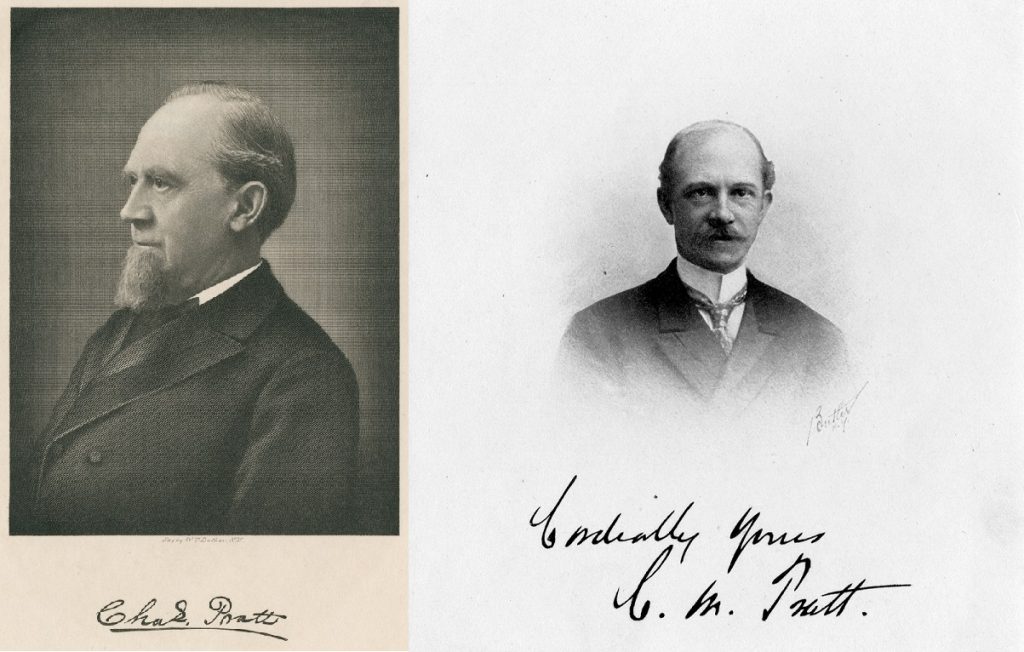
Left: Charles Pratt, Brooklyn Historical Society. Right: Charles M. Pratt, Amherst College Archives and Special Collections
In this 1910 trip, Henry Clay Folger travels to Lexington, Kentucky, home of his namesake; Kentucky statesman Henry Clay died in 1852, five years before Henry Clay Folger was born. From that era until today, parents name male babies after the man who served in the Senate and the House of Representatives where he was Speaker, and Secretary of State. Kentucky’s Favorite Son helped found the National Republican Party.
Let’s turn our attention to the postcards which attract Folger.
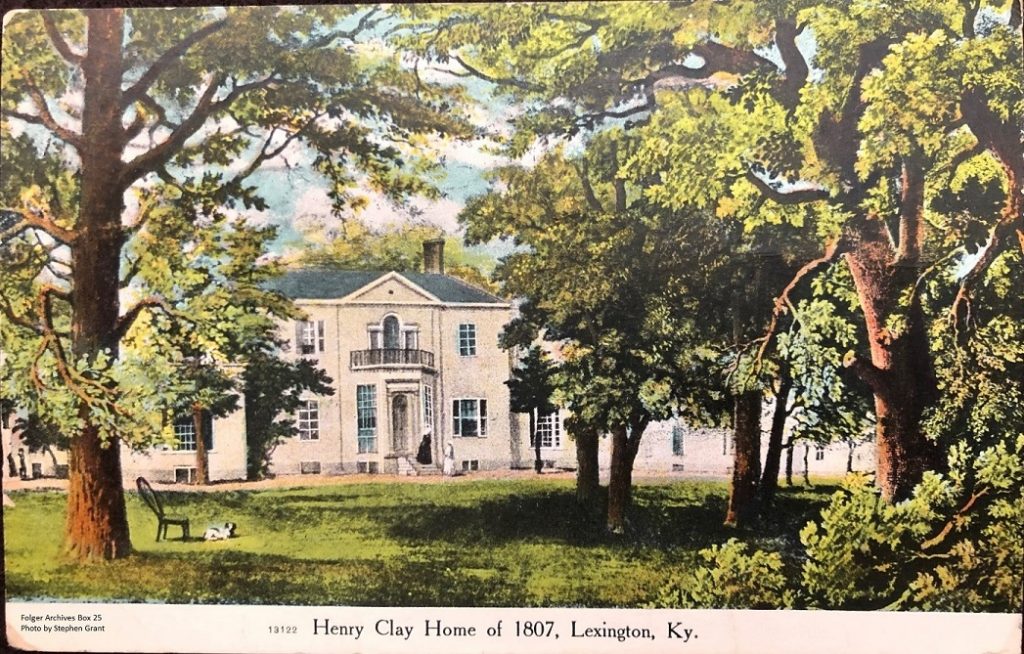
Henry Clay Home of 1807, Lexington, Ky. Folger Archives Box 25, photo by Stephen Grant.
A dog is lying alert next to an empty chair under a tree. The lady of the house stands near the front door. In other versions of this picture on Google the colors are different and Clay is sitting in his chair!
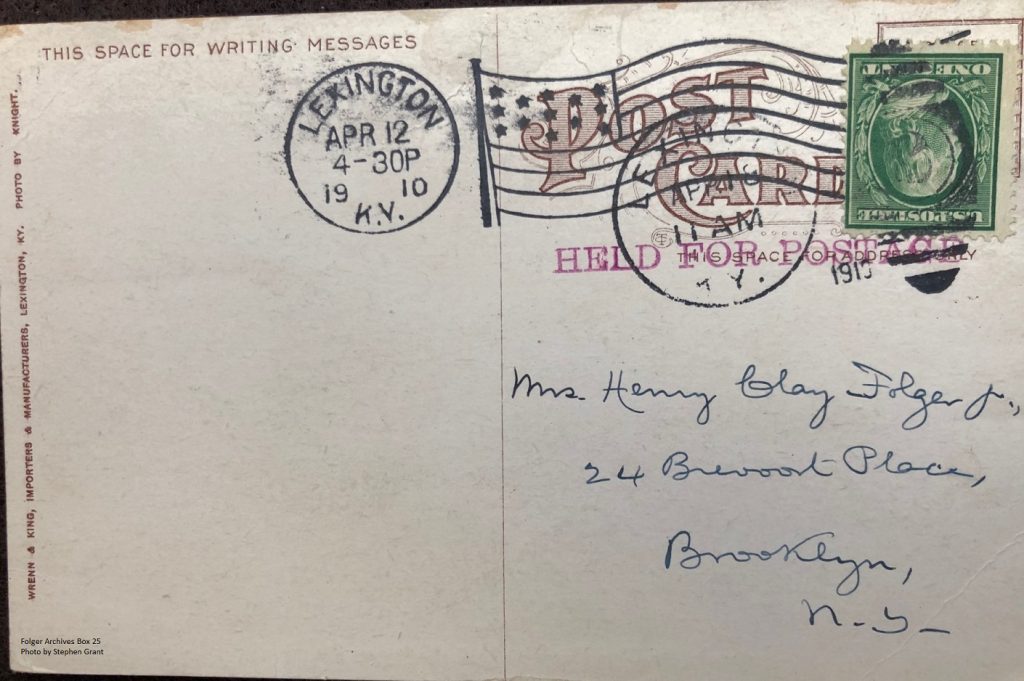
Message and Address side of same postcard
A man named Knight took the black and white photo. The photo was then hand tinted in different versions before being turned in a postcard. Every postcard is made up of three sheets of paper: the picture on one side, the address/message on the other, and a sheet in-between. Wrenn & King were the importers and manufacturers of the card. In this period many postcards sold in the U.S. were manufactured in Germany due to the superiority of their printing presses. Henry Folger’s finger prints are on this card that was posted on April 12, 1910 in Lexington in the afternoon. But after he marks his wife’s name and address, why does he not write a message? Staring him in the face is, in capital letters, “THIS SPACE FOR WRITING MESSAGES.” Does Henry freeze? I found no evidence that Henry has ever written a message on a picture postcard. We know that Henry and Emily did not exchange love letters, as they were almost always near one another.
Readers, raise your hand if you have ever sent a postcard to someone without a message. I have not. I don’t know why Henry does it. But I do know that he puts the card in the mailbox without a stamp. Look carefully, there are two cancellations. The green one-cent Franklin stamp is affixed over the first cancellation. Way back in 1910, did putting the stamp upside down signify “I love you”? Postal authorities could do two things when a piece of mail had insufficient postage: find the sender and remind him or her the U.S. mail system is not free and pay up, or send the mail on its way and mark on the envelope “POSTAGE DUE,” trying to collect on the receiving end. We will see both practices reflected in the postcards in the Folger archives.
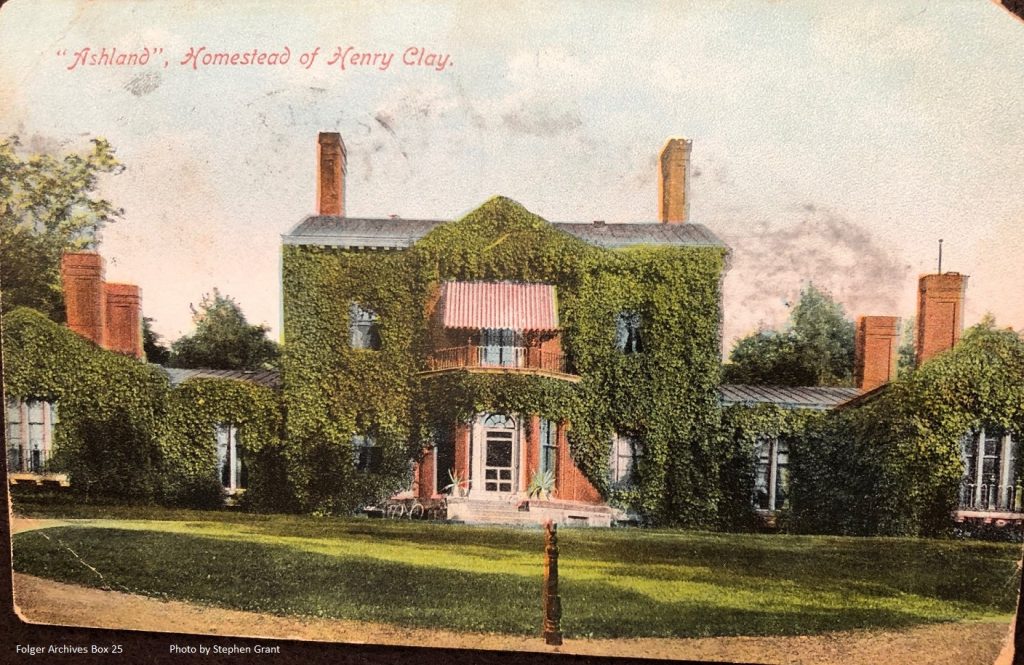
“Ashland,” Henry Clay Home, Lexington, Ky. Folger Archives Box 25, photo by Stephen Grant.
Ivy-covered mansion with no people or trees; a lone bicycle on the ground near the front door.
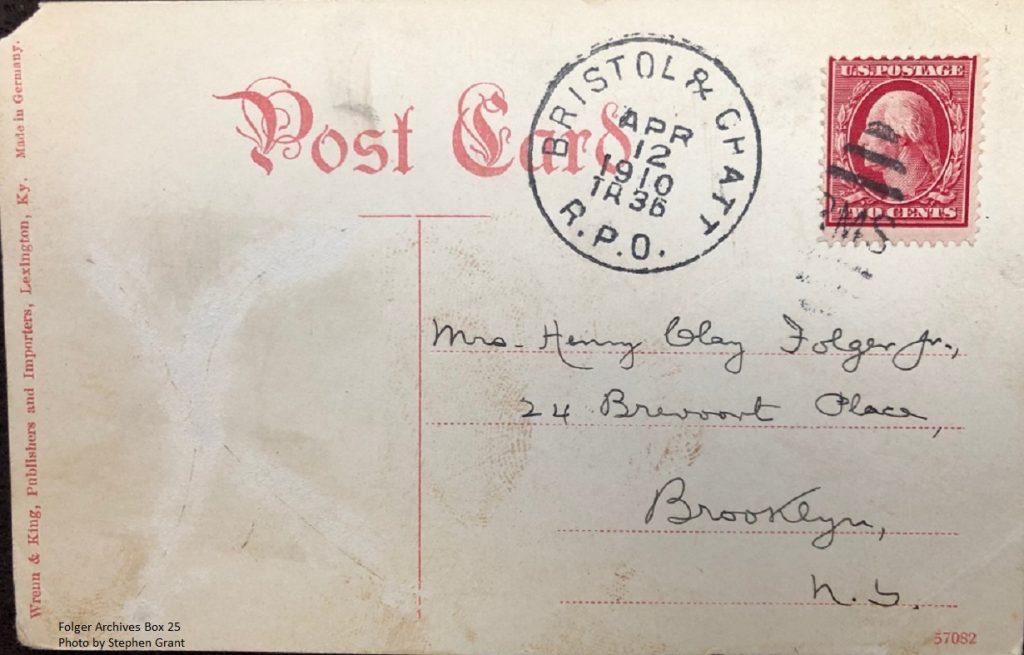
Message and Address side of same postcard
Now this is interesting, a second postcard Henry addresses to Emily on the very same day. I don’t think I’ve ever sent two postcards to anyone on the same day. He is consistent in writing no message to his spouse. But, Henry my man, there are other virtues in life than consistency. Come on, you can do it! This is 1910; you were married in 1885. This year is your silver anniversary year of marriage. Why not celebrate? Fill in the entire message space on the card. Or even spill over a bit, the way you did when you wrote your mother your freshman year of college. Will Emily agree that no news is good news? He puts no stamp initially on the first card, and a red Washington two-cent stamp on this card. Why two-cent, when only a one-cent is required? We find confirmation that the postcard was printed in Germany. R.P.O. signifies Railway Post Office. Folger had the postcard cancelled while on board the train.
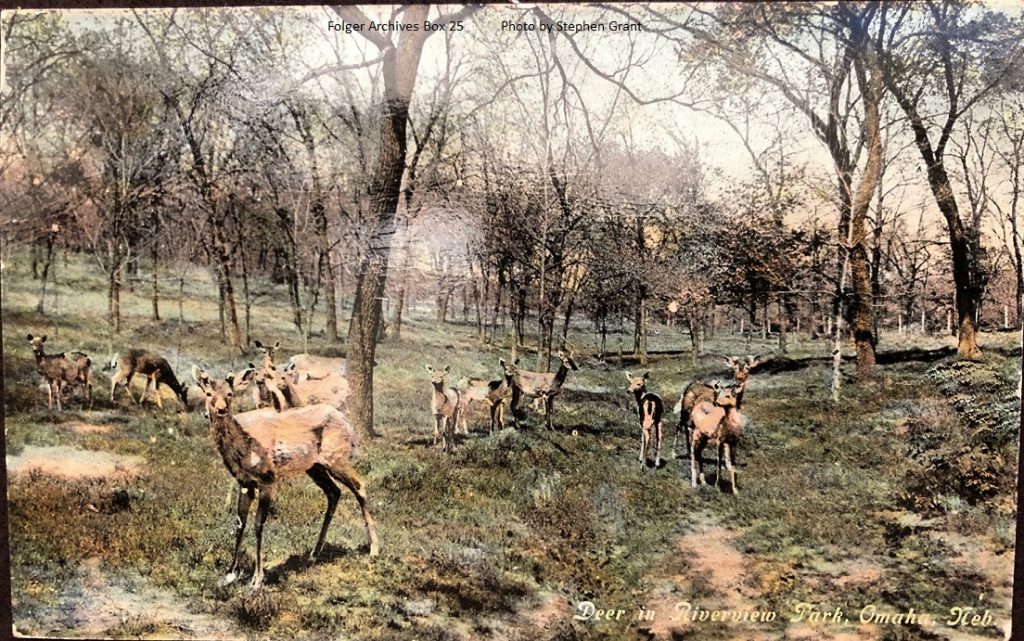
Deer in Riverview Park, Omaha, Neb. Folger Archives Box 25, photo by Stephen Grant.
Now Folger and the Standard Oil Company delegation have traveled from Lexington, KY to Omaha, NE. Again, this is a black-and-white photo that has been hand tinted, and there are what looks like a sun spot near the middle of the photo.
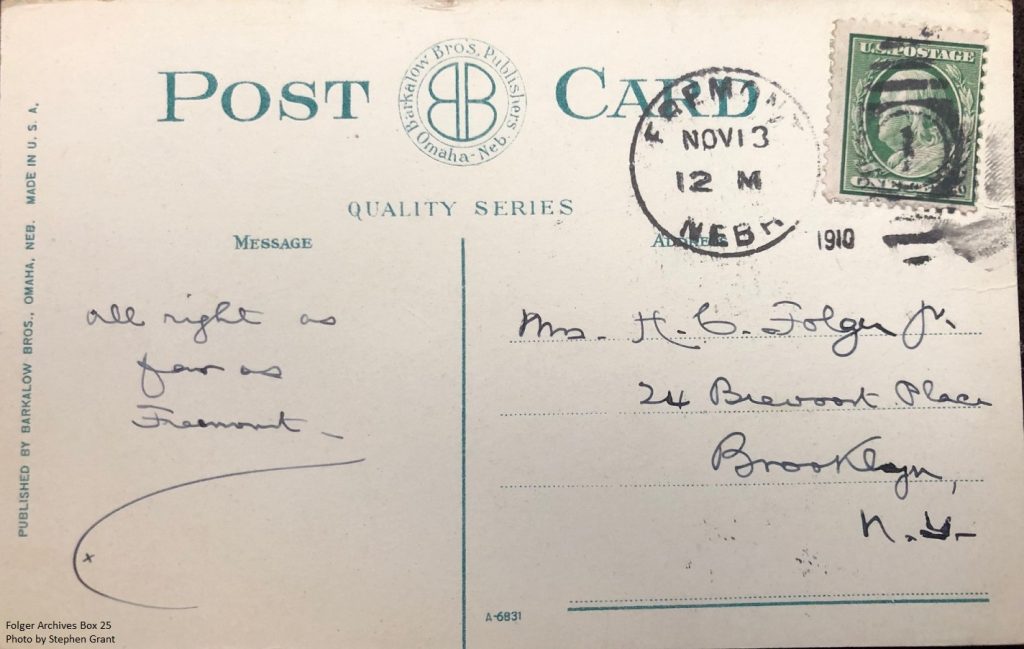
Message and Address side of same postcard
The card was published by Barkalow Bros., Omaha Neb. in its “Quality Series.” YAY! Henry, you did it! I knew you could. Three cheers for Henry Clay Folger! He has gotten it together. He puts a one-cent on the card before sending it. And, after two tries, he decides to actually pen his wedded wife some thoughts he has formulated with these six words: “All right as far as Fremont.” That is, Fremont, NE. If everything is all right, then there is no reason to write? The message is not gushy romantic, nor does he reveal any Standard Oil Company secrets between the lines. “All right as far as Fremont” is not a line to be remembered but it’s a start to their postcard correspondence. I’ve read more postcard messages than the next man. Never have I come across a correspondent who, with nothing else to say, fills in the remainder with two lines and an “x.” Was it to discourage a freeloader from adding his or her two cents worth?
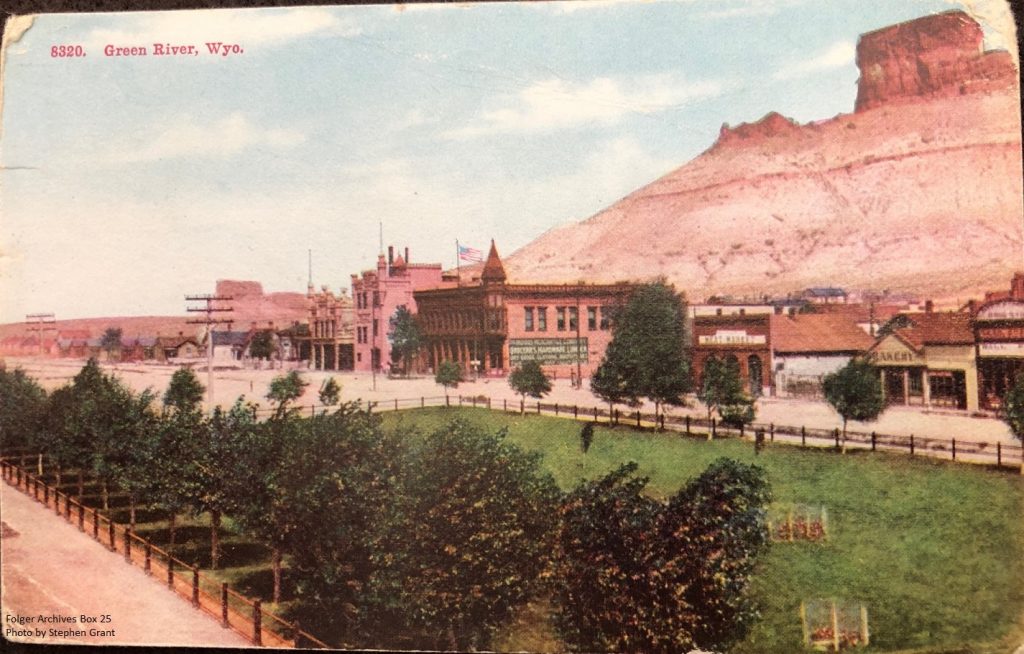
Green River, Wyo. Folger Archives Box 25, photo by Stephen Grant.
In the town of Green River, WY, we see a park, row of young trees, telegraph posts, meat market, bakery, no vehicles, one person standing under a sign, and a towering geological formation in the background.
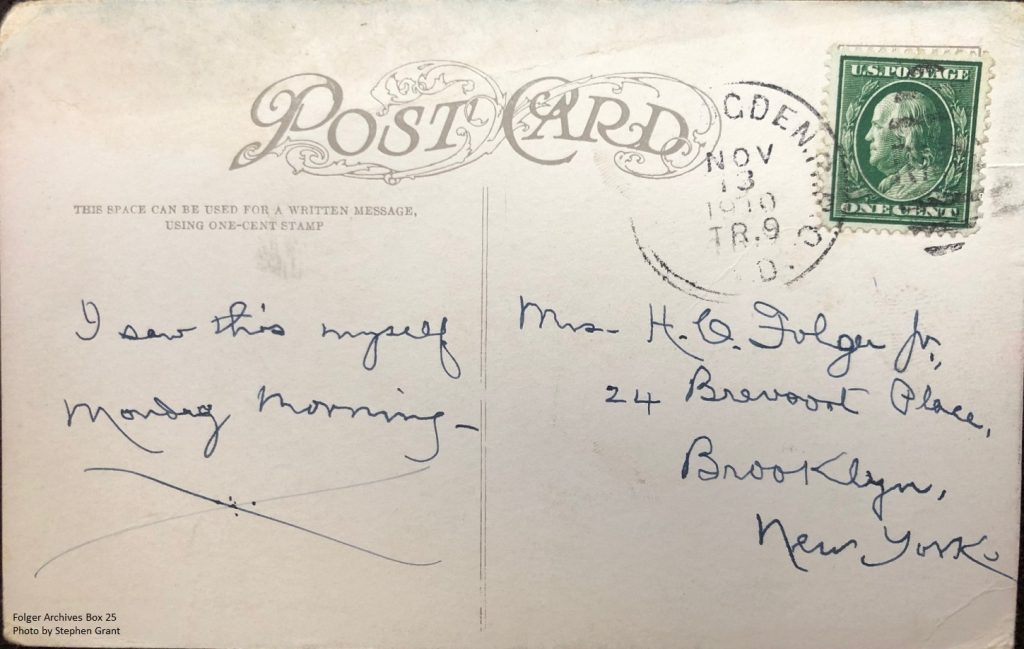
Message and Address side of same postcard
Yay, the upright pronoun! Folger is finally inserting his persona into the western geography. What do we learn? “I saw this myself Monday morning.” What will Emily think when she reads her husband’s six words (again) from three-quarters of the way across the country? Oh, Henry, what a missed opportunity! Again, Folger crosses over the empty space on the card to assure his privacy.
Contemplate the message, “This space can be used for a written message, using one-cent stamp.” “This space” refers not to the left side of the card but the entire side. Curious choice of words. Postal customers in 1910 are not used to having a prescribed space for the message. Up until 1907, according to Universal Postal Union regulations, one whole side of the postcard was reserved for the address. Hey, wait a minute. The postmark says Ogden, Nov. 13. It’s not the same trip! The “Company men” would not go on an eight-month inspection tour.
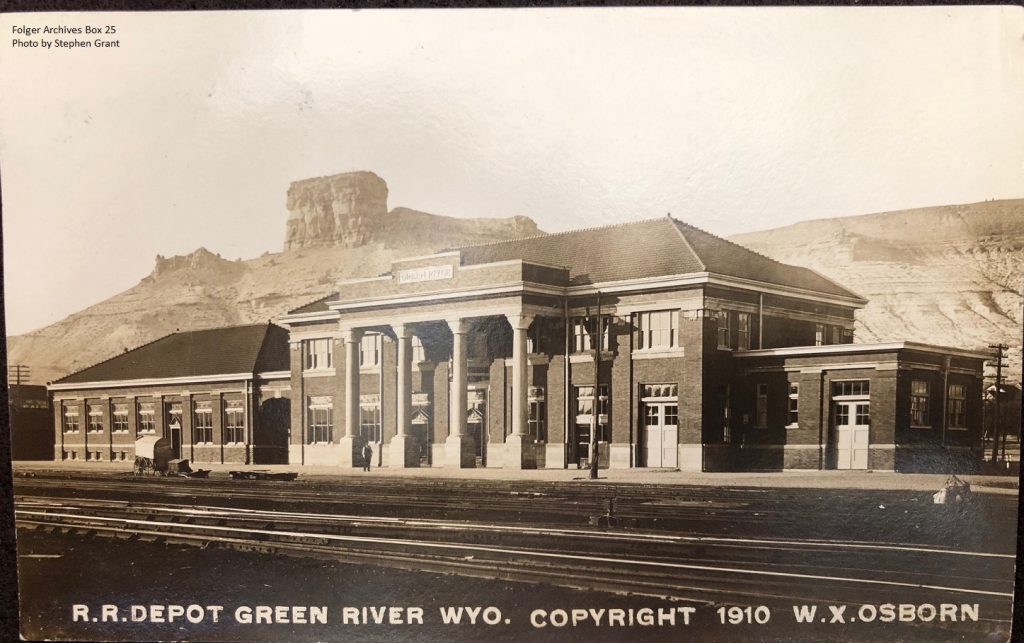
R. R. Depot, Green River, Wyo. Folger Archives Box 25, photo by Stephen Grant.
Note the same stone formation behind the empty Depot as behind the meat market and park. This is a black-and-white card, while all the others Henry sends are in color. The resolution is excellent. We see the Green River sign above the four columns, a lone conductor standing on the platform, a covered two-wheel wagon for transporting baggage. No train, no passengers.
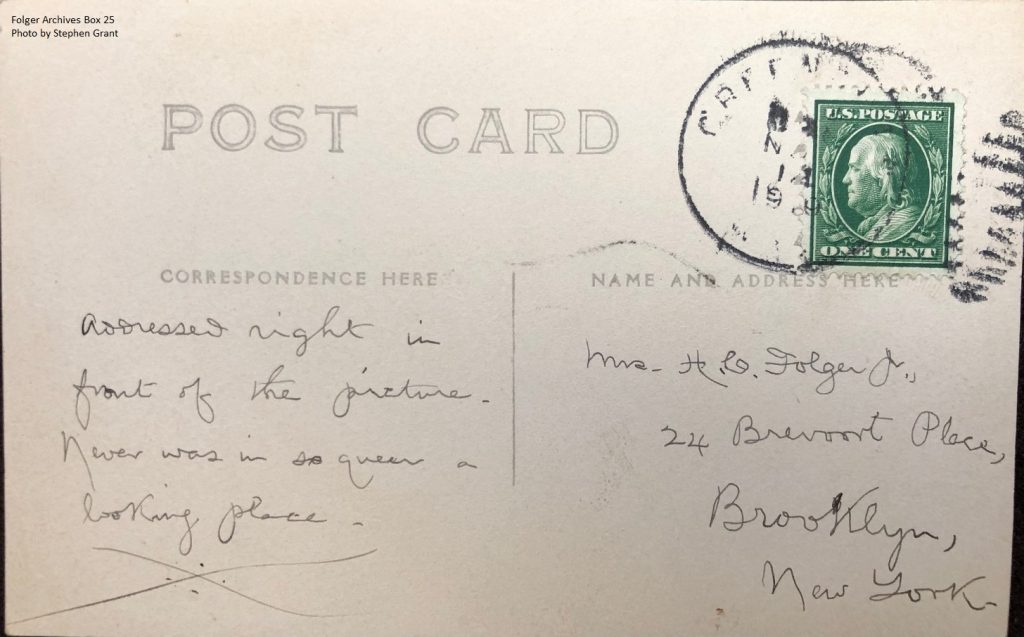
Message and Address side of the same postcard
This message is written on Nov. 14, 1910, the day after the preceding card. Henry splurges with fifteen words. “Addressed right in front of the picture. Never was in so queer a looking place”? Folger is sitting looking at the railroad station when he addresses the card to his wife. This fact gives the message a new kind of spontaneity. Does he mean to write “in so queer-looking a place”? A little tipsy at the time, was he, Henry? Nope, just a lapse. Folger was a teetotaler after college.
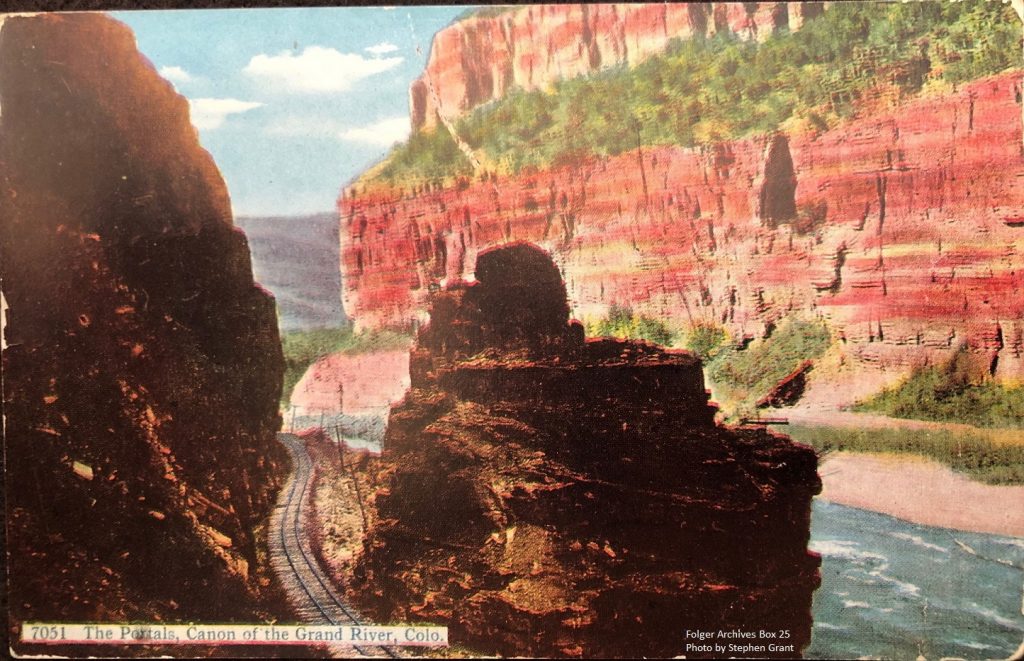
The Portals, Canon of the Grand River, Colo. Folger Archives Box 25, photo by Stephen Grant.
We see the familiar red stone formation along the Green River. We’ve moved from Wyoming to Colorado. The Green River is a tributary of the Colorado River.
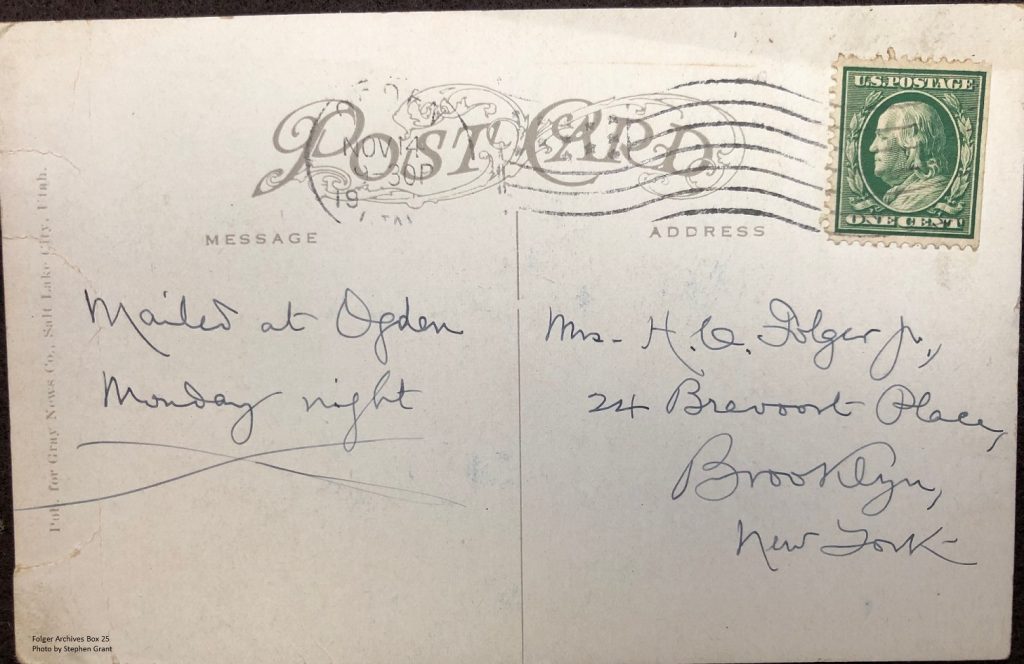
Message and Address side of same postcard
Published for Gray News Co., Salt Lake City, Utah. Two cards of the seven we have looked it contain the swirling calligraphy in and around POST CARD. “Mailed at Ogden Monday night.” We are down to five words, “Mailed at Ogden Monday night,” the least he has written his beloved on these western trips. This card was mailed on Nov. 14, 1910, the same day as the preceding card. He gets the one-cent stamp right this time. Does Emily run to the door when she hears the postman? What will I hear about his trip out west? Perhaps her expectations are no higher than a sign of life.
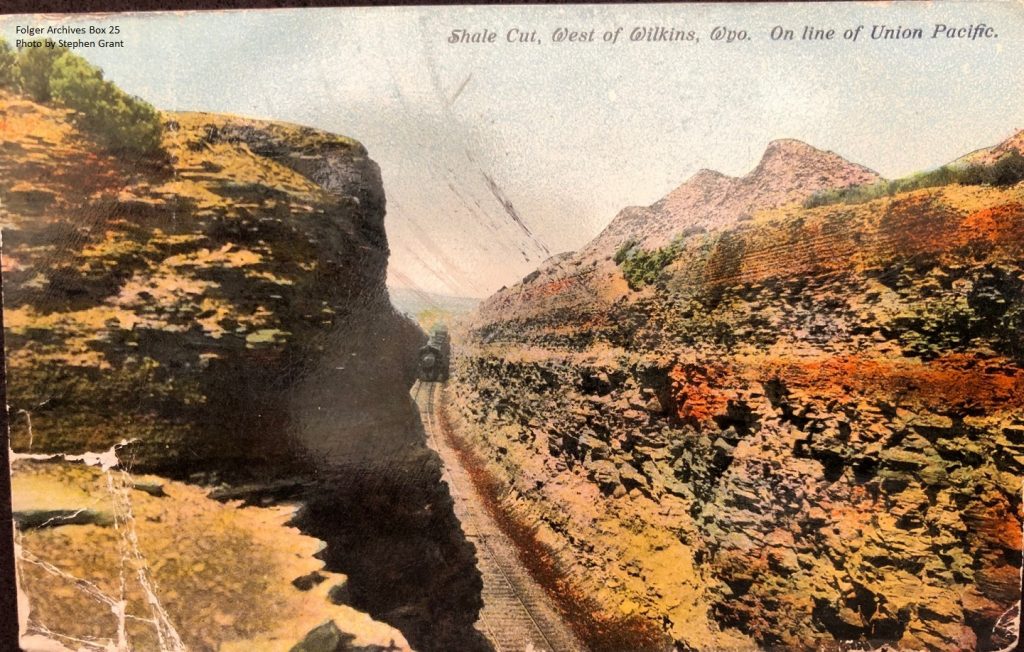
Shale Cut, West of Wilkins, Wyo. On line of Western Pacific. Folger Archives Box 25, photo by Stephen Grant.
A dramatic photo with a Union Pacific locomotive chugging right toward the photographer. Oil shale is rock that holds deposits of fossilized algae that never received sufficient pressure to produce crude oil. Today, U.S. companies extract shale oil and gas via hydraulic fracturing (fracking). A century ago, Standard Oil Company inspection teams were already visiting sites to examine possibilities of oil exploration.
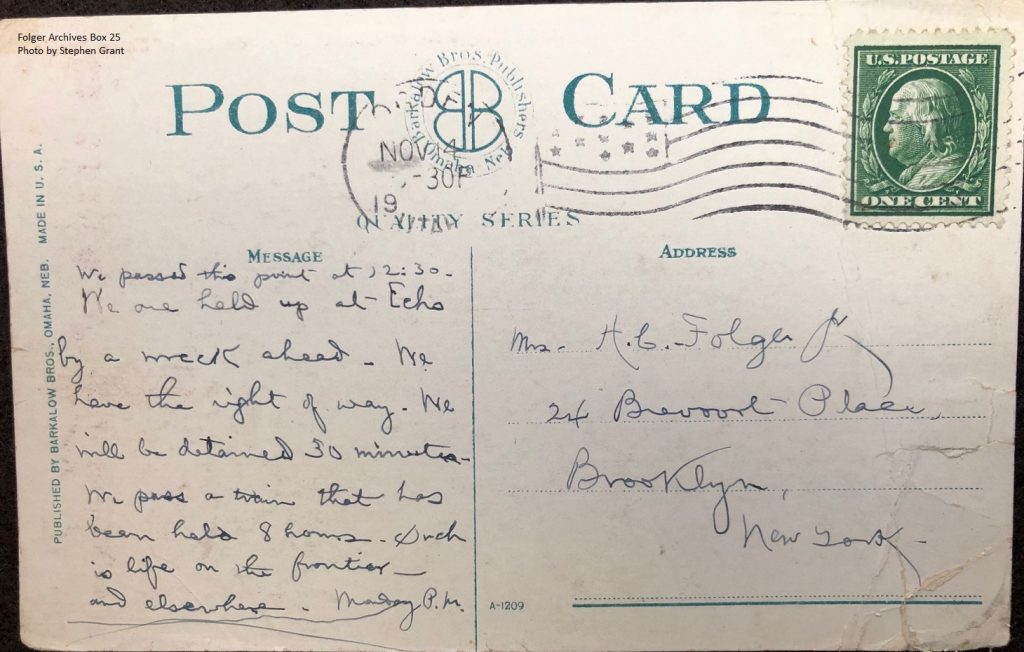
Message and Address side of same postcard
This is the second card in the lot published in the Quality Series by Barkalow Bros., Omaha Neb. The first was numbered A-6831 and this one A-1209. One can infer that this is a big production company with thousands and thousands of picture postcards of different sites. Postmark is Nov. 14, 1910, making the card the second one he mails that day. Folger’s expansive message: “We passed this point at 12:30. We are held up at Echo by a wreck ahead. We have the right of way. We will be detained 30 minutes. We pass a train that has been held 8 hours. Such is life on the frontier and elsewhere. Monday P.M.” Only one line left, but still a crossed line to fill in the message space. After a record 48 words Folger penned, we are witness to our first philosophical observation from Henry Folger on the trip: life on the frontier is unpredictable.
(This post was originally published on the Folger Shakespeare Library’s research blog The Collation on October 9, 2019.)
COMMENTS:
1 Comment
Submit a Comment
CONNECT

Absolutely wonderful. Stepping back in time. Yes- thank goodness he did write her on these trips. These are my favorite postcards I have ever seen on your site- I feel like I am right there!